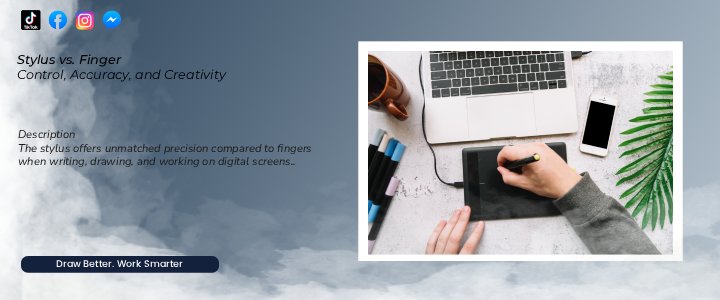Stylus And Finger For Tablets/Smartphones
When it comes to interacting with touchscreens, two tools dominate the experience: the stylus and finger. While your fingertip is always available and natural to use, a stylus offers greater precision, comfort, and control — especially for creative work, note-taking, or detailed editing. In the world of tablets and smartphones, understanding the difference between the stylus and finger can completely change how efficiently you work or create.
Let’s dive into how each method performs in terms of accuracy, comfort, cleanliness, and overall user experience.
1. Precision and Control
The most noticeable difference between using a stylus and finger is precision. A stylus tip is far smaller and more pointed than a fingertip, allowing you to touch exact pixels on the screen.
This precision is essential for:
- Digital art and design
- Note-taking and handwriting
- Editing photos or videos
Selecting text or small interface elements
When using your finger, you’re limited by its size and shape — great for scrolling or tapping, but not ideal for tasks that require fine control. The stylus mimics the feel of a pen or brush, letting you work naturally with detail and accuracy that’s impossible with your fingertip.
2. Comfort and Ergonomics
Comfort plays a huge role in productivity. Using your finger for long periods can strain your hand and wrist, especially when writing or drawing. A stylus, on the other hand, is ergonomically designed for prolonged use.
Styluses also reduce friction, allowing smoother gliding across the screen surface. This makes activities like sketching, signing documents, or annotating PDFs feel effortless.
Meanwhile, fingers may leave smudges and oil on the screen, which not only looks unappealing but can also affect touch sensitivity over time.
3. Cleanliness and Screen Maintenance
Another key difference between stylus and finger usage is cleanliness. Every time you touch your screen with your hands, natural oils and dirt transfer onto the surface, creating smudges and fingerprints.
Stylus pens eliminate that issue completely. By minimizing direct contact, they help keep your screen clean, clearer, and more hygienic — especially important for shared devices or touchscreens used in professional settings.
Here’s a quick comparison:
| Feature | Stylus | Finger |
|---|---|---|
| Precision | High — perfect for writing and drawing | Low — suitable for general navigation |
| Comfort for Long Use | Ergonomic and natural grip | Can cause fatigue during extended use |
| Screen Cleanliness | Stays clean and smudge-free | Leaves fingerprints and oil marks |
| Control | Precise and responsive | Less accurate for fine tasks |
| Best Use Case | Art, note-taking, professional work | Casual browsing and quick tasks |
As shown above, the stylus wins in precision, cleanliness, and comfort, while the finger still excels in convenience and accessibility.
4. The Convenience Factor
Of course, the finger remains unbeatable when it comes to convenience. You don’t need to charge it, carry it, or worry about losing it. For quick actions like scrolling social media, typing short messages, or tapping apps, your finger is always ready.
However, modern styluses have evolved too. Many are now rechargeable with long battery life, Bluetooth connectivity, and even palm rejection technology — allowing you to rest your hand naturally on the screen while writing or drawing.
These advancements make the stylus more practical than ever for students, designers, and professionals.
5. Productivity and Creativity Boost
When comparing stylus and finger performance in real-world use, productivity is where the stylus shines brightest. It helps you write notes faster, edit with precision, and interact with digital tools more efficiently.
For students, it means clearer notes and better engagement during lectures. For professionals, it enhances multitasking and creative workflows. Artists can sketch, shade, and color with the control of a real pen — something fingers simply can’t replicate.
6. Choosing What’s Right for You
Ultimately, the choice between a stylus and finger depends on how you use your device:
- Use a Stylus if you frequently draw, write, or perform detailed editing tasks.
- Use Your Finger if you mainly browse, type, or watch videos.
- Use Both for a balanced approach — convenience for casual use and precision for productivity.
This hybrid approach lets you switch seamlessly between comfort and control depending on the situation.
Conclusion
In the debate of Stylus and Finger, there’s no absolute winner — just different tools for different needs. Your finger offers unmatched accessibility, while the stylus provides the precision, cleanliness, and control required for serious work and creativity.
As tablets and smartphones continue to evolve, the stylus has become more than an accessory — it’s a productivity essential for anyone who values precision and comfort. Whether you’re a student, artist, or professional, choosing the right input method can transform the way you interact with your device and bring your digital experience to a whole new level.



